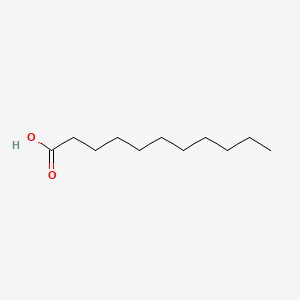| MeSH term | MeSH ID | Detail |
|---|---|---|
| Alopecia | D000505 | 14 associated lipids |
| Hemolysis | D006461 | 131 associated lipids |
UNDECANOIC ACID
UNDECANOIC ACID is a lipid of Fatty Acyls (FA) class. The involved functions are known as Anabolism, Mitosis, Transcriptional Activation, Mismatch Repair and Transcription, Genetic. Undecanoic acid often locates in Protoplasm and spindle microtubule. The associated genes with UNDECANOIC ACID are TERT gene. The related lipids are Fatty Acids and undecanoic acid.
Cross Reference
Introduction
To understand associated biological information of UNDECANOIC ACID, we collected biological information of abnormalities, associated pathways, cellular/molecular locations, biological functions, related genes/proteins, lipids and common seen animal/experimental models with organized paragraphs from literatures.
What diseases are associated with UNDECANOIC ACID?
There are no associated biomedical information in the current reference collection.
Possible diseases from mapped MeSH terms on references
We collected disease MeSH terms mapped to the references associated with UNDECANOIC ACID
PubChem Associated disorders and diseases
What pathways are associated with UNDECANOIC ACID
There are no associated biomedical information in the current reference collection.
PubChem Biomolecular Interactions and Pathways
Link to PubChem Biomolecular Interactions and PathwaysWhat cellular locations are associated with UNDECANOIC ACID?
Visualization in cellular structure
Associated locations are in red color. Not associated locations are in black.
Related references are published most in these journals:
| Location | Cross reference | Weighted score | Related literatures |
|---|
What functions are associated with UNDECANOIC ACID?
Related references are published most in these journals:
| Function | Cross reference | Weighted score | Related literatures |
|---|
What lipids are associated with UNDECANOIC ACID?
Related references are published most in these journals:
| Lipid concept | Cross reference | Weighted score | Related literatures |
|---|
What genes are associated with UNDECANOIC ACID?
Related references are published most in these journals:
| Gene | Cross reference | Weighted score | Related literatures |
|---|
What common seen animal models are associated with UNDECANOIC ACID?
There are no associated biomedical information in the current reference collection.
NCBI Entrez Crosslinks
All references with UNDECANOIC ACID
Download all related citations| Authors | Title | Published | Journal | PubMed Link |
|---|---|---|---|---|
| Pozo OJ et al. | Quantification of testosterone undecanoate in human hair by liquid chromatography-tandem mass spectrometry. | 2009 | Biomed. Chromatogr. | pmid:19353724 |
| Pesek JJ et al. | Aqueous normal-phase retention of nucleotides on silica hydride columns. | 2009 | J Chromatogr A | pmid:19135674 |
| Shen XW et al. | Production and characterization of homopolymer poly(3-hydroxyvalerate) (PHV) accumulated by wild type and recombinant Aeromonas hydrophila strain 4AK4. | 2009 | Bioresour. Technol. | pmid:19395256 |
| De Lisi R et al. | Thermodynamics of surfactants, block copolymers and their mixtures in water: the role of the isothermal calorimetry. | 2009 | Int J Mol Sci | pmid:19742173 |
| Kigathi RN et al. | Emission of volatile organic compounds after herbivory from Trifolium pratense (L.) under laboratory and field conditions. | 2009 | J. Chem. Ecol. | pmid:20013039 |
| Saad F et al. | A dose-response study of testosterone on sexual dysfunction and features of the metabolic syndrome using testosterone gel and parenteral testosterone undecanoate. | 2008 Jan-Feb | J. Androl. | pmid:17916569 |
| Webb CM et al. | Effects of oral testosterone treatment on myocardial perfusion and vascular function in men with low plasma testosterone and coronary heart disease. | 2008 | Am. J. Cardiol. | pmid:18308009 |
| Attardi BJ et al. | Dimethandrolone (7alpha,11beta-dimethyl-19-nortestosterone) and 11beta-methyl-19-nortestosterone are not converted to aromatic A-ring products in the presence of recombinant human aromatase. | 2008 | J. Steroid Biochem. Mol. Biol. | pmid:18555683 |
| Brito-Madurro AG et al. | A single amino acid substitution in one of the lipases of Aspergillus nidulans confers resistance to the antimycotic drug undecanoic acid. | 2008 | Biochem. Genet. | pmid:18516670 |
| Opitz S et al. | Increased terpenoid accumulation in cotton (Gossypium hirsutum) foliage is a general wound response. | 2008 | J. Chem. Ecol. | pmid:18386096 |
